
In April 2017, Mitch Waxman, a member of the Newtown Creek Alliance, conducted one of his Newtown Creek tours, his most comprehensive, which he called “Creek-a-Thon”. It was an all-day affair comprising approximately 8 hours with over ten miles of walking. I accompanied the group on the first leg of the tour, but finding myself hopelessly behind the rest, I decided to call it a day when we got to the now-deceased Goodfellas (originally Clinton) Diner on Maspeth Avenue. (Sometimes I feel I am the only native New Yorker who walks slowly.) A few weeks later, in a walk that included me and filmmaker Heather Quinlan, we mostly covered the remainder of the tour. The weather was warm for late April, approximately 80 degrees.
I have over 100 photos from that second leg and while I will skip a few it will take more than one post to get through them all, since I have stopped doing 100-photo post extravaganzas. Since I brought up the rear as usual, you will see three people in some photos, mostly from the back: Mitch, Heather and Mitch’s friend Don, who has accompanied Mitch and I to other forays such as the Rockaways.
Picking up where I left off at the end of Part 1 at the Scott Avenue Footbridge:

At the corner of Randolph Street and Scott Avenue (yes, there is a Randolph Scott corner, though the Westerns star of the 30s through the 50s likely never heard of it) are a pair of Quonset huts. The Quonset hut by definition is a lightweight structure made of corrugated steel built with a semicircular cross section. It was developed during WWII at Quonset Point, in a naval construction area near Kings Point, Rhode Island; it is actually a variant of the Nissen Hut first used during World War I. I don’t know the current tenants but the huts have been cleaned since 2017 and a picture window has been added to the one on the right.

The practice of throwing sneaker laces, with the sneakers still attached, has been a tradition for decades in NYC though no one can pinpoint when and where it first began. Someone was the first to do it, and it slowly spread all over town.

Now in the heart of East Williamsburg, at Johnson and Porter Avenues we noticed a newly painted building sign for the Peter Jay Sharp Center in snappy black and white with the Copperplate font, an FNY favorite. It turns out that this is a homeless shelter, albeit one that has designs for being a cut above the usual:
The Porter Avenue shelter, called the Peter Jay Sharp Center for Opportunity, was built as the first step in replacing an 800-bed men’s shelter near Bellevue Hospital Center, currently the primary entrance point for single homeless men into the shelter system. That facility, in the original Bellevue Psychiatric Hospital, is an authentic piece of Gotham Gothic, with dark hallways smelling of industrial cleaners and bedrooms with rickety beds and ratty wool blankets.
Unlike the Bellevue shelter, the Porter Avenue shelter will be operated not by the city but by an independent nonprofit contractor, the Doe Fund. The Doe Fund runs a 150-bed shelter in Harlem, but that is only for homeless men who have decided to be part of Ready, Willing and Able, a work and lifestyle training program of the Doe Fund. The new shelter will have 100 beds for assessing the needs of men right off the street, 150 beds for men awaiting placement in programs elsewhere, and 100 beds in the Doe Fund’s work program. [NY Times, 12/7/03]

Sadly, Cape House Clam Shack at #2 Knickerbocker Avenue at Johnson Avenue had closed by 2021, a likely Covid-19 victim.

Still in the land of industry and barbed wire our group turned north on Morgan Avenue…
Atlantic Avenue isn’t the only Long Island RR foray into Brooklyn. Morgan Avenue crosses the western end of the Bushwick Branch of the Long Island Rail Road. The tracks are still operational and are used to move garbage cars and freight cars pulled by diesel along unelectrified tracks. Royal Mix Cement, a block west, is a main customer. The tracks connect to the LIRR Montauk tracks at about 60th Street in Ridgewood. In the dim past, the Bushwick tracks carried passenger trains, as the Montauk tracks between LIC and Jamaica did as late as 2003.
The engine had his lights on but wasn’t moving. If he were, the overhead red lights would be flashing. Service is too infrequent to warrant crossing gates, though fences that protect the tracks have to be unlocked and opened when a train is running. The branch is brought over English Kills, east of Morgan Avenue, on a rickety bridge that Mitch has braved, but not me.
Sign sampler along Morgan Avenue at Stagg. Arrogant Swine, also closed now, was a bistro.
200 Morgan Avenue, across from Meadow Street, is home to the M. Fine Lumber Co. as well as Nula Stdios, one of a number of photography and event studios in the East Willie.

This large building at the NW corner of Morgan Avenue and Stagg Street was built for Max Schaffer Lighting Fixtures. It is now home to numerous art studios and offices including Brooklyn Greens, Vimeo, cinema venue Light Industry as well as architectural studios. East Willie is also a premier venue for colorful amateur artwork; some of these people would make excellent commercial illustrators.

A glimpse of English Kills and some docked boats from Morgan Avenue.

Painted sign for the long-departed Rainbow Polybag on Stagg Street.
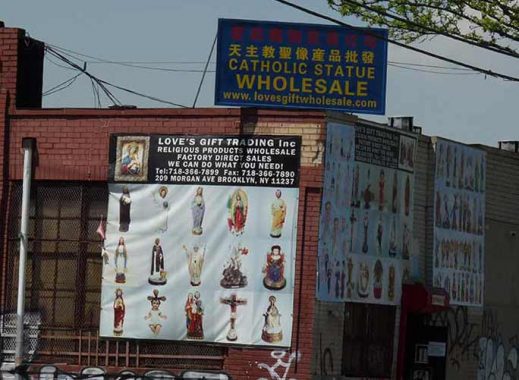
If you need religious statues, candles, crosses, pendants, Nativity scenes for worship or to hide your drug purchases, Love’s Gift Trading will get them to you wholesale at Morgan Avenue and Meadow Street. This is a part of town where anything can be found.

Morgan Avenue. You also got free lifetime chips. This building has been demolished since 2017.
I have often wondered about the original purpose of this large, brick fortress-like building at the NE corner of Grand Street and Morgan Avenue in East Williamsburg, just west of the bridge that carried both Grand Avenue and Metropolitan Avenue across English Kills, a tributary of Newtown Creek.
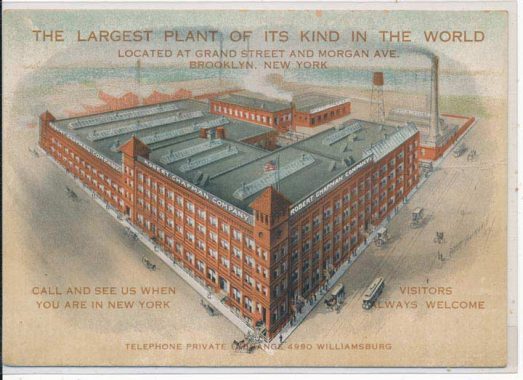
I wonder no more, since seeing a postcard during a task I performed for the Greater Astoria Historical Society a few years ago, scanning in thousands of postcards from collector Bob Stonehill. This one depicts the building when it was the Robert Chapman Stationery Company. Presumably, Chapman manufactured paper products.
The entire building, which runs through to Metropolitan Avenue and Morgan, has lost its pointed caps on the corner turrets, but not much else. The plant even still has its old smokestack intact. More recently, it has been home to sweatshops.
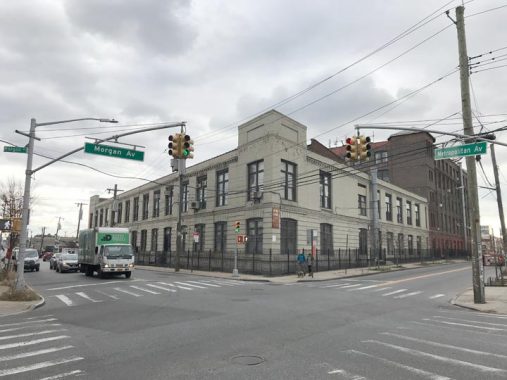
Air conditioning was invented in eastern Brooklyn. The first air conditioned building — in the world — was located at 1024 Metropolitan Avenue at Morgan Avenue at what was printing plant, Sackett & Wilhelms. When NYC was in the midst of a blistering heat wave in July 1902, the just-completed plant was turning out the then-popular magazine Judge, which featured color photos and thus used a four-color printing process. The printing plant’s management didn’t take into account that Newtown Creek would make the air sticky and humid, causing the paper to expand, the four colors (cyan, magenta, yellow, and black) fail to line up properly, and the ink fail to dry quickly enough.
A junior engineer from a furnace company, Willis Carrier, was the first to figure out that the problem wasn’t, as the now hackneyed phrase goes, the heat, but the humidity. Carrier built a device that used fans, ducts, and perforated pipes to dehumidify the second floor of the printer, where the presses were, and in 1903 added a refrigerating machine to both cool and dry the air. The printing problems were solved with the added benefit of providing a comfortable working environment in the summer months. Thus began a worldwide enterprise that made parts of the United States, the equatorial belt, and much of the Southern Hemisphere much more comfortable to work in and, in some cases, habitable.
And it all happened because of Newtown Creek, and running ink.
This walk was done on a weekday, at the pedal-to-the-metalist time of day at Metropolitan and Vandervoort Avenues (plenty of letters at that intersection) near the industrial parks of the East Willie and across the Creek, Maspeth.
Colossal Media Hand Painted Outdoor Advertising is located on a ramp on Metropolitan Avenue descending to Newtown Creek alongside the Met Ave. Bridge, providing some Creek views. The building is younger than it looks and was built in 2017.
In a land of industry, a residential block stands out, and what a residential block. The still-not Landmarked Beadel Street between Vandervoort and Porter Avenues. According to Mitch Waxman,
Moses Beadel was a Wallabout coffin ship patriot, his son and grand sons were also named Moses Beadel… They farmed, not so successfully, but got involved with the rendering game and became largish manufacturers (for the early 1900’s) of tallow for candles. Like all the old families, they had huge upland holdings.
His grand daughters married well, and carried deeds for most of the former “Arnheim” into the marriage as their dowry. The new in-laws were named Cooper, and that’s how Peter Cooper ended up owning the vast tracks of land on Furman Island, which is where the Cooper Houses are, which is where his factory was. Nearby, Martin Kalbfleisch had established a very large chemical factory nearby the modern corner of Vandervoort and Metropolitan not far from the south west side of the Met Avenue Bridge. [Newtown Pentacle]
Beadel Street is one block of the tidiest, neatest, well-maintained brownstone and brick buildings you could ever hope to see, a respite in this land of tractor trailers.
From there it was back to industry as we walked along Lombardy Street which is the north end of the vast East Williamsburg Industrial Park. This used to be where a pair of huge gas tanks serving Brooklyn Union Gas/Keyspan/National Grid stood until they were imploeed in July 2001. I was once stopped from taking photos through a fence by a guard.
For a couple of years two Kosciuszko Bridges stood beside the other, the old K that opened in 1939 and one of the pair of new cable-stayed spans that opened in 2017. The second span opened two years later, and the Old K was demolished and scrapped.

Newtown Creek has also been spanned by a series of “Penny Bridges” connecting Meeker Avenue and Calvary Cemetery from the mid-19th Century until 1939. The abutments for the Penny Bridges are still in place.
From here we headed generally west into Greenpoint and the G train.
As always, “comment…as you see fit.” I earn a small payment when you click on any ad on the site. Take a look at the new JOBS link in the red toolbar at the top of the page on the desktop version, as I also get a small payment when you view a job via that link.
9/24/23

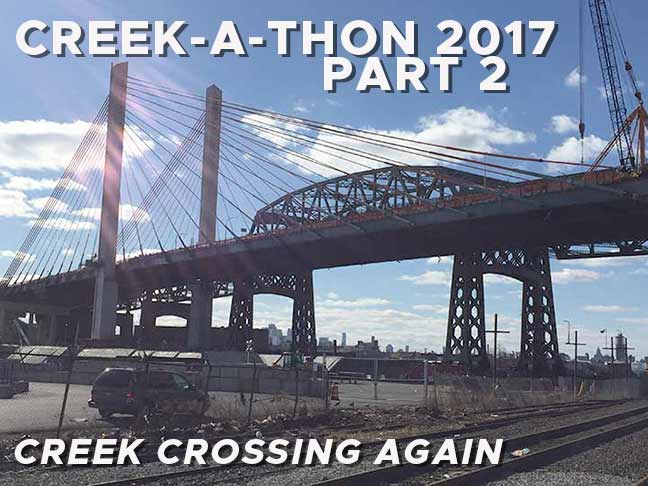
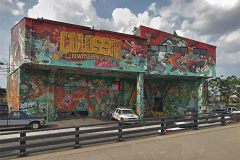
7 comments
Sneakers hanging from the wires means that narcotics are for sale nearby
When I was a kid, it had a far less sinister implication, it was simply something we did on the way home from the last day of school in June.
Ive heard of Wallabout Bay near the Navy Yard but a “Wallabout coffin ship patriot”?
Ya got me on that one
American Soldiers taken prisoner in the Battle of Long Island were confined aboard British ships anchored in Wallabout Bay. Most died of their wounds or from the horrible conditions. The memorial In Ft. Greene Park is to those men.
The words were kind of misleading.I thought that if anyone actually survived those ships
they wouldnt be in any condition anyway to do anything.What I cant figure out is the prison
hulks stayed in NY long after the British had left and how come Washington and them didnt
try and rescue them.Also those ships had to be resupplied periodically by the British.I think
something could have been done.
The British departed New York on November 25, 1783, which is known as Evacuation Day. For many years it was celebrated in New York as a holiday. The British employed the prison ships from 1776 until 1783, only stopping when they left New York. There was little that George Washington could have done to effect any type of rescue, as the British fully held the city until Evacuation Day.
They could have grabbed a bunch of Britishers and put THEM in hellholes in
a harbor.There was little they could have done to effect any type of rescue in other
parts of the country